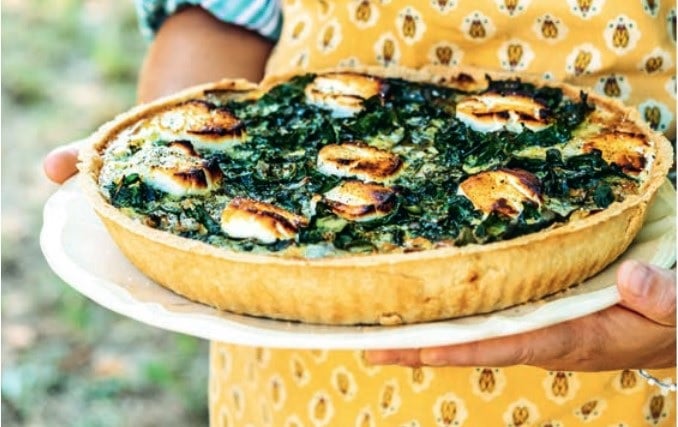The town of Nice has given us more than just salade Niçoise.
This Tarte de Blettes (chard tart) inspired by the classic local recipe for tourte de blettes, is reminiscent of medieval pies, with its unconventional ingredient combination by modern palate standards. Though here we keep the apples from the traditional tourte, this tart sits firmly in the savory camp.
I have the food writer and cook Sophie Missing to thank for this delicious pastry recipe. It is blind-baked in two stages, which ensures the bottom stays crisp when the wet filling goes on top. Quiches and savory tarts can be prepared in advance and served at room temperature: useful when hosting and serving multiple courses.
Recipe reprinted with permission from Provence: The Cookbook by Caroline Rimbert Craig with photography by Susan Bell (Simon & Schuster 2023).
Ingredients
For the pastry:
- •Generous 2 cups (9½ oz/270 g) all-purpose flour, plus extra for dusting
- •Good pinch of salt
- •9½ tablespoons (4¾ oz/135 g) cold butter, plus extra for greasing
- •3–4 tablespoons cold water
- •1 egg, beaten for brushing
For the filling:
- •2¼ lb (1 kg) chard
- •1 leek
- •3 tablespoons olive oil, plus extra for drizzling
- •1 large sweet apple
- •4 eggs
- •3 sage leaves, finely chopped
- •2 sprigs of rosemary, leaves finely chopped
- •Generous ¾ cup (200 ml) crème fraîche
- •1 teaspoon Dijon mustard
- •6½ oz (180 g) goat cheese, crumbled or sliced
- •Salt and freshly ground black pepper


Preparation
Begin with the pastry: add the flour and salt to a bowl and whisk together. Chop the butter into cubes and rub it into the flour with your fingertips. When it has a breadcrumb-like texture, mix in the first tablespoon of water. Keep adding the water, a tablespoon at a time (four in total usually suffice), mixing and squeezing the mixture with your hands until the pastry comes together into a ball. Wrap in plastic and chill in the fridge for 30 minutes while you make the filling.
Trim and wash the chard. Use a knife to separate the green tops from their pale stalks. Roughly chop the stalks into 1½ inch (4 cm) chunks. Shred the greens, setting aside a large handful for the topping. Trim and wash the leek, then slice it into ¾ inch (2 cm) rounds.
Place a deep frying pan over medium heat and add the olive oil, chard stalks, and leek. Sprinkle with salt and black pepper and then cook, stirring frequently, for about 5 minutes. Place a lid on the pan and cook for a further few minutes while you peel, core, and roughly chop the apple into ¾ inch (2 cm) chunks. Stir the apple pieces into the pan and put the lid back on.
After another 5 to 10 minutes, add all but the reserved handful of shredded greens and place the lid on to steam. If your pan is too small, add the greens in two batches: add a first load, then place the lid on the pan. Once they have wilted and made space, add the second batch and repeat the steaming process. Remove the lid once the greens have wilted and keep stirring. When all the vegetables are silky and tender, turn the heat off.
After the pastry has chilled for at least 30 minutes, preheat the oven to 400˚F (200˚C) and thoroughly grease an 11 inch (28 cm) quiche pan with butter and line the base with parchment paper. Remove the pastry from the fridge and roll into a circle on a piece of parchment paper lightly sprinkled with flour. Continue rolling to enlarge the circle until the dough is just ⅛ inch (3 mm) thick, and wide enough to cover the pan and then some. Lightly flour your rolling pin and the dough if necessary as you do this to prevent it from sticking.
Pick up the pastry, parchment paper and all, and flip into the pan. Gently push into position, trim the excess dough, and prick the base with a fork. Place the piece of parchment paper back on top of the pastry and fill the base with pie weights. Blind-bake the pastry for 10 minutes, then remove from the oven. Remove the weights and the top piece of parchment paper, then brush the surface of the pastry with the beaten egg, reserving any leftovers. Place the dish back in the oven for 5–10 minutes, until lightly golden. You may need to rotate the dish to color the pastry evenly.
While the pastry is in the oven, crack the eggs into a mixing bowl, and add any leftover egg you used to brush the pastry. Add the chopped herbs and crème fraîche, then whisk. Season with salt and black pepper.
Once the pastry is ready, remove from the oven and spread the mustard over the base. Distribute the chard and apple filling evenly in the pastry base, then pour the egg mixture on top. Sprinkle over the raw shredded greens you set aside earlier, and finish with the goat cheese and a final extra drizzle of olive oil.
Bake for 25–30 minutes, or until the filling has set, and remove from the oven. Remove the quiche from the pan. Wait at least 30 minutes before slicing and serving.

